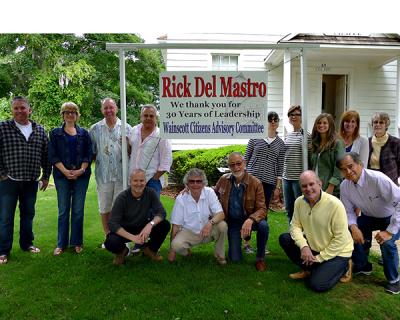Wainscott Citizens Honor Del Mastro
Wainscott Citizens Honor Del Mastro

The Wainscott Citizens Advisory Committee honored one of its own on Saturday, presenting Rick Del Mastro, a committee member for 30 years, with a custom baseball cap and a banner put up outside the Wainscott Chapel.
Mr. Del Mastro, 70, has been a Wainscott resident since 1979. He has been the chairman or co-chairman of the committee 10 times, including this year. Dennis D’Andrea, another longtime committee member, said Mr. Del Mastro had been “the thread that has run through the W.C.A.C.’s entire 30-year history.”
“Whatever side of an issue a committee member or member of the public was on, he insisted that everyone be heard fairly,” Mr. D’Andrea said in an email. “He wanted everyone who spoke before the committee to be assured they would be addressing open minds. The Wainscott committee came to be known as the Athens of the C.A.C.s.”
The East Hampton Town Board appoints members of the Citizens Advisory Committees to advise the board on matters that concern their hamlets.
Mr. Del Mastro’s contributions to public service stretch beyond the town limits. He is the owner of outdoor advertising, marketing, and event planning businesses, and also heavily involved with Life’s WORC, a Garden City-based non-profit organization that supports individuals with autism and other mental health challenges and their families. Mr. Del Mastro recently cut the ribbon on the Family Center for Autism in Garden City, and called the organization one of his passions. He is also passionate about the Wainscott community, and while he will soon step down as chairman, he said he would continue to be very involved.
“I love Wainscott. I’ve gotten to know the people and the landscape, and for all the years I’ve been there, we’ve worked on trying to maintain Wainscott and make it the best home it can be,” Mr. Del Mastro said in an interview. “We feel very proud of what we have accomplished. . . . The nice thing is the relationship you build with the people who live in the hamlet. I consider them not only neighbors, but friends.”
